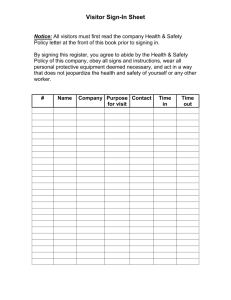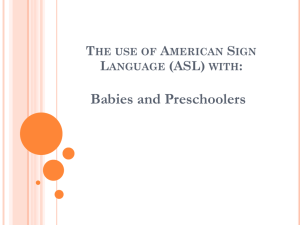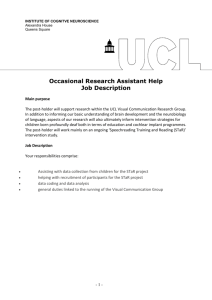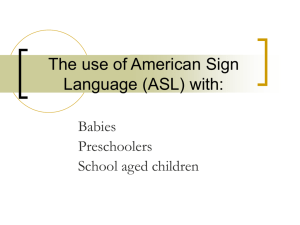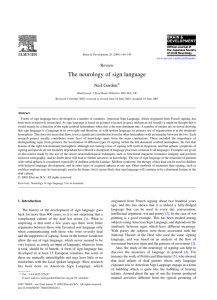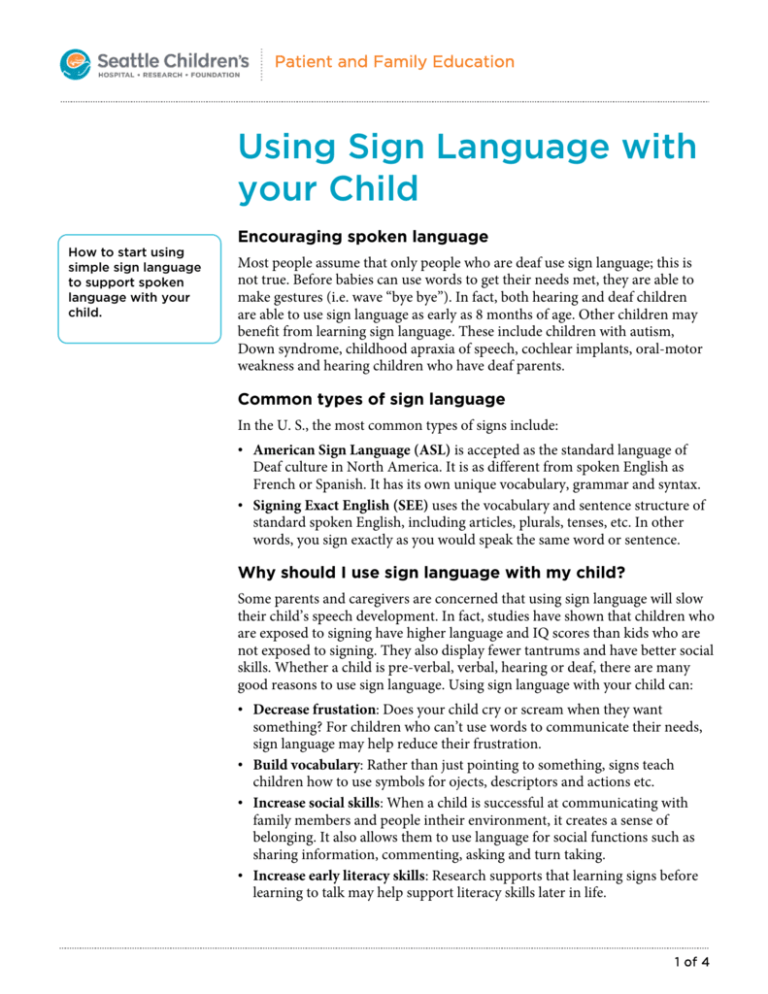
Patient and Family Education
Using Sign Language with
your Child
Encouraging spoken language
How to start using
simple sign language
to support spoken
language with your
child.
Most people assume that only people who are deaf use sign language; this is
not true. Before babies can use words to get their needs met, they are able to
make gestures (i.e. wave “bye bye”). In fact, both hearing and deaf children
are able to use sign language as early as 8 months of age. Other children may
benefit from learning sign language. These include children with autism,
Down syndrome, childhood apraxia of speech, cochlear implants, oral-motor
weakness and hearing children who have deaf parents.
Common types of sign language
In the U. S., the most common types of signs include:
• American Sign Language (ASL) is accepted as the standard language of
Deaf culture in North America. It is as different from spoken English as
French or Spanish. It has its own unique vocabulary, grammar and syntax.
• Signing Exact English (SEE) uses the vocabulary and sentence structure of
standard spoken English, including articles, plurals, tenses, etc. In other
words, you sign exactly as you would speak the same word or sentence.
Why should I use sign language with my child?
Some parents and caregivers are concerned that using sign language will slow
their child’s speech development. In fact, studies have shown that children who
are exposed to signing have higher language and IQ scores than kids who are
not exposed to signing. They also display fewer tantrums and have better social
skills. Whether a child is pre-verbal, verbal, hearing or deaf, there are many
good reasons to use sign language. Using sign language with your child can:
• Decrease frustation: Does your child cry or scream when they want
something? For children who can’t use words to communicate their needs,
sign language may help reduce their frustration.
• Build vocabulary: Rather than just pointing to something, signs teach
children how to use symbols for ojects, descriptors and actions etc.
• Increase social skills: When a child is successful at communicating with
family members and people intheir environment, it creates a sense of
belonging. It also allows them to use language for social functions such as
sharing information, commenting, asking and turn taking.
• Increase early literacy skills: Research supports that learning signs before
learning to talk may help support literacy skills later in life.
1 of 4
Using Sign Language with your Child
• Increase motor development: By producing signs, the child practices
coordinating their hand and body movements. This not only improves
motor skills, but may help stimulate speech production.
Where do I begin?
Once you decide to start signing with your child, you should choose words
that are basic and general enough to use in many places. For instance, the sign
and word “more” can be used to ask for more juice, kisses, music, turn the TV
back on etc.
Start with basic words and add more words as your child progresses. Share
your signs with your child’s caretaker, therapist or teacher to make sure you
all use the same signs. If speech is your child’s goal, always say the words
while signing them. Some simple starter signs are listed below.
Helpful hints
It won’t happen overnight, but with time words will come for most children.
If your child is not talking or they continue to struggle during interactions,
contact a speech pathologist for answers specific to your child’s needs.
Every child is different. You cannot force a child to talk if they are not
ready, but you can help them use words and signs by creating opportunities to
communicate. For instance, keep toys and snacks out of reach. When your
child shows interest in these, model a sign while also saying the word. Always
give a delay after you sign and say the word. This gives your child some time
to imitate your gesture.
Your child’s signs may not be exactly like yours, so accept signs that are
close. Once your child tries to make the sign, provide a reward by giving them
the requested object or action right away. This strengthens the association
between the symbol (sign) and the object or action. Some children need
“hand-over-hand” help. In such cases, an adult guides the child’s hands to
create a sign before giving them the requested object or action.
2 of 4
Using Sign Language with your Child
Examples of common signs*:
Mom
Dad
More
All done
Eat
Milk
Dog
Cat
3 of 4
Patient and Family Education
To Learn More
What do I do next?
• Speech & Language
Services 206-987-2104
• Ask your child’s
healthcare provider
• www.seattlechildrens.org
Make a list of objects and actions that your child likes and may request. This
may include names of things (car, milk, and bear), names of people (Mommy,
Grandpa) and requests for actions (tickle, swing, sleep). Include some ways to
communicate such as how to say ‘yes’ and ‘no’, and showing pain (hurt). After
you have created a list for your child, visit one of the signing books or online
dictionaries below to find and learn the new signs. Most libraries also have
books and videos demonstrating signs.
Resources:
Free Interpreter
Services
• In the hospital, ask
your child’s nurse.
• From outside the
hospital, call the
toll-free Family
Interpreting Line
1-866-583-1527. Tell
the interpreter the
name or extension you
need.
• For Deaf and hard of
hearing callers
206-987-2280 (TTY).
Websites:
• My Baby Can Talk at www.mybabycantalk.com
• ASL Pro www.aslpro.com/cgi-bin/aslpro/aslpro.cgi
• American Sign Language Browser
commtechlab.msu.edu/sites/aslweb/browser.htm.
• Baby Sign Language www.babysignlanguage.com
Books:
• “Sign with your Baby: How to Communicate with Infants Before They Can
Speak,” (2001), Joseph Garcia.
• “Baby’s First Signs,” “More Baby’s First Signs” and “A Book of Colors,” by
Kim Votry and Curt Waller, Gallaudet Press. These colorful books feature
illustrations of a toddler signing a word with a picture demonstrating what
the sign is about. The illustrations include a diagram that depicts exactly
how to perform the sign and the English word.
*Images used with permission from Baby Sign Language, www.babysignlanguage.com all rights
reserved.
Adapted with permission from Super Duper Hand Handouts, “Encouraging Spoken Language
through Signs” by Jennifer Vroom, MS, CCC-SLP and “Should I Teach My Baby to Sign” by Susie S.
Loraine, M.A., CCC-SLP.
Seattle Children’s offers interpreter services for Deaf, hard of hearing or non-English speaking patients, family members and
legal representatives free of charge. Seattle Children’s will make this information available in alternate formats upon request.
Call the Family Resource Center at 206-987-2201.
This handout has been reviewed by clinical staff at Seattle Children’s. However, your child’s needs are unique. Before you act
or rely upon this information, please talk with your child’s healthcare provider.
© 2014 Seattle Children’s, Seattle, Washington. All rights reserved.
Speech & Language Services
5/14
PE1906
4 of 4



